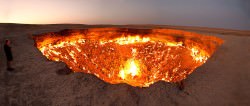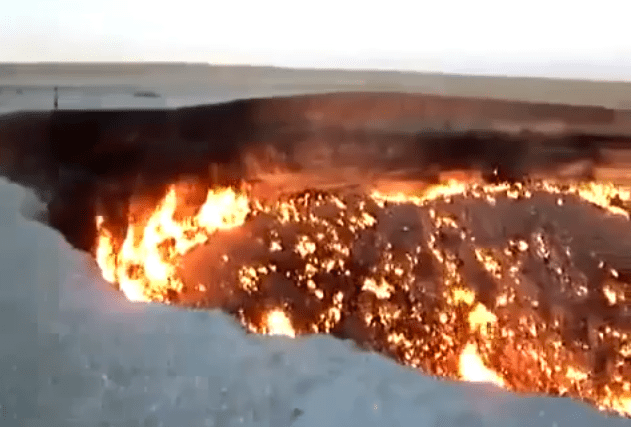There’s been a lot of really incredible videos and images of the meteor that streaked across Russian skies on Feb. 15, 2013… but this isn’t one of them.
I recently spotted it on YouTube, uploaded by several users and claiming to be a crater from the meteorite. Whether done purposely to deceive or just in error, the fact is that this isn’t from that event. Actually it’s not even a meteorite crater at all.
What this video shows is a feature in Derweze, Turkmenistan. It’s the remains of a 1971 drilling project by Soviet geologists. When the ground under their rig collapsed after breaking into an underground cavern full of natural gas, the geologists decided to set the borehole on fire to flare off the gases.

They assumed all the gas would soon burn off and the fire would go out. But it’s still burning today, nearly 42 years later.
The fiery glow from the circular pit has inspired the hole’s local name, “The Door to Hell.” You can find some photos of this infernal feature here.
Anyway, in the nature of not only informing but also preventing the spread of disinformation, hopefully this will help clear up any confusion for those who might run across the same video in coming days. News about the Russian meteor is still — no pun intended — very hot right now, and it’s likely that at least a few fraudulent articles might try to garner some attention.
If you want to see some real videos of the meteor, check out our original breaking news article here and see some photos of an actual resulting crater — icy, not fiery — in a frozen Russian lake here.
In order to not make for more easy hits on the incorrectly-titled video I did not set it to play. If you do still want to watch it, you can find it here.


WOW! That is quite the ‘Oopsey’! The link above mentions the president of Turkmenistan has ordered the hole to filled in… good luck with that! I WOULDN’T want to be the heavy equipment operator doing the deed.. no sireee! Reminds of the coal mine fire in Pennsylvania that has been burning for 50 years… http://en.wikipedia.org/wiki/Centralia,_Pennsylvania
Yeah Centralia came to mind!
It’s amazing how quick the lies get posted, the hoaxers were spinning before the shockwave hit. I guess there’s some click profit in it somewhere, but it seems to be so natural for some people I wonder if there’s some kind of evolutionary pressure that makes hominids jump on the internet and lie about asteroids.
Great to see Universe Today in there cracking on the liars.
Eeyup… UT’s reporters and editors work long and hard to get the truth out. Cudo’s to them and all their hard work for doing that! The perps of half truths have an agenda.. it’s called stupidity. “Look what i can do!” followed by a snit fit dance while shaking their butts in our faces… BAD MONKEY! SIT!
So, this should be named a “mteorwrong crater”, rite?
And now, I run…..
The hole would be so easy to fill up by pushing soil in with a bulldozer from the surrounding soil heaps, mounds or small hills visible in the photos. The scoop bit of the bull dozer would offer some protection from the heat radiation though there seems to be little need for this as people can approach the fire from quite up close. If the fire has been burning for 42 years it might burn for another 42 or even longer. Doesn’t that make it economically viable as a potential source of natural gas fuel once capped? I know that it seems quite out of the way, but as it is I feel like opening a kebab house beside it offering some really nice naan bread.
Questions might be.. What has that burn done to soil(s) cohesion in the area? How extensive is that burn below the ground? If the original drill head sank into a hole, then how big it that cavity now? These are all unknown factors and I for one would suggest EXTREME caution and wouldn’t get within a mile of the site….
I don’t know much about this but it would seem that the only contact area with oxygen for natural gas to burn in would be at the hole itself. Otherwise flames would have spread elsewhere, as happens in underground coal mines after localised ignition burns a considerable distance to other places having depleted any fuel to consume at its original source. Therefore soil cohesion must be solid enough for the latter not to happen and for the gas to seep out elsewhere. I agree, some underground penetrating mechanism with which to map the subterranean cavernous structure would be useful to determine whether an angle of approach for a bulldozer would be better than another one. Best avoid another ground collapse because it might increase the present rate of burning which seems constant relative to the size of the hole. After checking for any other possible gas seepage nearby and stopping the fire with soil bulldozed over it, I’d cap the hole with a cheap tough material akin to a pond liner using an inbuilt tapped outlet for the gas to be utilized. Who knows, if what I mention were done, the nearby community of Erbent might benefit from an extra source of income thus making the local economy more wealthy. If all you need is minimal labour, a bulldozer and a pond liner to make use of the gas then that would be a very cheap investment creating a huge profit.
I think I’d rather hit it with a couple of plane loads of fire retardent before getting anyone close. If that option weren’t available a half dozen or so of those helicopter carried buckets of water in close succession would be my 2nd choice.
As in Tungusta, there will be no ‘found’ crater as the culprirt was probably a gas ball.
Remember that infamous photo by NASA that showed a ball with a tail linked to the sun? Well, I think that was and this event was a gas ball. During this time of high compression the products of the sun will be able to be packaged tightly.
The question is: was it radioactive?
Wait — you think the meteor was actually a ball of gas blown out of the Sun?
Hmm, 2 days and no Uranus jokes.
An explosion resulting from a gas ball can also produce a crater. That’s what an atomic bomb does — create rapidly expanding gases and radiation. (Not that I agree with the premise. Meteors may produce craters or not; various factors decide what reaches the ground and how fast.)
That’s obviously the Springfield Tire Fire.
This is a video of the Russian Meteor Sonic Boom http://youtu.be/6w2AsGazCcg